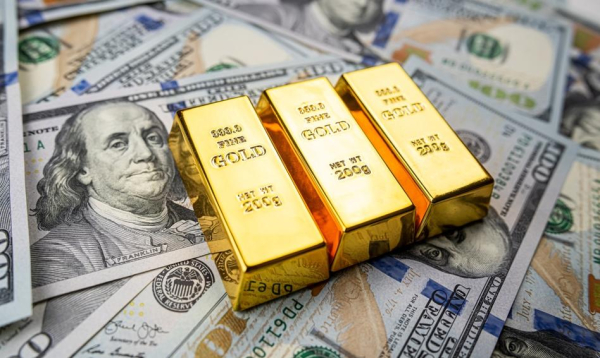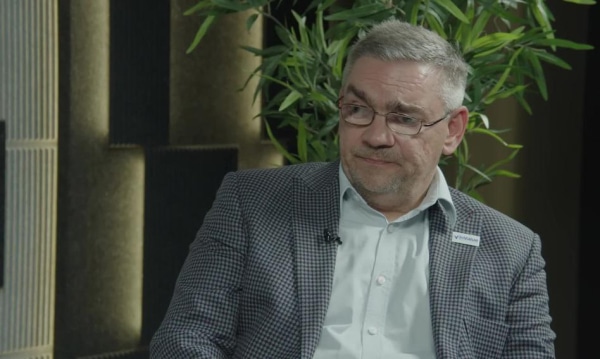Prices of 5 thousand dollars, and in unfavourable conditions even 10 thousand dollars, for an ounce of gold are definitely achievable. I believe that a second wave of inflation is ahead of us. According to my estimates, we will soon pay 3.50 zlotys for a dollar, or maybe less – indicates Adam Drozdowski, manager of InValue Multi-Asset funds, in an interview with Bankier.pl.

Tomasz Goss-Strzelecki, Bankier.pl: The recent rapid increase in gold prices and records above 3,500 dollars per ounce were described by some as madness. But you have been talking about such and even higher levels for a long time…
Dr. Adam Drozdowski, InValue Multi-Asset Fund Manager: That's right. A lot of it is due to historical relationships. In a calendar year when the dollar weakens, gold prices go up by an average of 26.2%. In a year when the dollar strengthens, we usually have a 2.2% drop in gold prices. This has been happening since the 1970s, when gold prices were freed up.
Last year the dollar strengthened by 7%, and gold went up by 27%. This year the dollar is weakening, and significantly, by about 10% or even more. Gold went up by 30%, which is about the same as last year.
Just please note that in 2021-2022, when inflation in Poland reached almost 20% and in the US exceeded 9%, gold showed nothing for two years. In the first year it fell by almost 4%, in the second it went to zero. In my opinion, the arrears in quotations that the precious metal had to make up for in these two inflationary years, it has already made up for, becoming more expensive by over 70%.
In the short term, of course, we can expect a correction, even a significant one. The rate probably won't fall below $3,000, but it could reach $3,000 and a bit.
In the long term, however, if we consider what has happened in the fiat world and how much money has been printed in recent years – dollars have probably increased in circulation by about 70% since Covid – gold is definitely undervalued. As a result, its prices will continue to rise.


Bankier.tv
The report “In Gold we Trust” already indicated a price of $5,000 in 2019, and even $10,000 per ounce in unfavorable conditions. These are goals that are definitely achievable. I am talking about such levels, but I did not invent them myself, they are indicated by specialists.
What other factors, apart from the weak dollar, should support further increases in gold prices? What impact could Donald Trump's policies have?
The weakening of the dollar is certainly an important element, I have already mentioned its inverse correlation with gold prices. The second factor is geopolitics – and the tensions and uncertainty associated with it. Basically, most of the time there is some uncertainty, such is human nature, we are always afraid of something. That is why we look for safe investments.
The third factor is of course the fear of inflation. The fact that gold did not protect against inflation in 2021-22 does not mean anything, because it more than made up for it in the next two and a half years. Personally, I believe that we are facing a second wave of inflation and gold should protect against it perfectly.
Inflation is a mixed bag. Some markets see a chance of an acceleration, but most expect it to remain moderate and the Fed to cut interest rates four times this year…
Of course I look at expectations, but I don't draw any conclusions from that, because the market has already been wrong so many times about interest rates and recession.
After all, there was supposed to be a recession in 2022 “100 percent,” and it was also expected in 2023, but nothing like that happened. I look at what analysts are predicting very calmly. But I don’t attach much importance to it, because it has failed to come true many times.
How Long Can Gold's Rally Last? The current bull run began in the fall of 2022, when gold returned to gains after a 20%-plus correction.
The current bull market may continue for a very long time. Analogies can be found in the 1970s and early 1980s, when the increases lasted for over 10 years. Also in the current century, the entire first decade, up until 2011, was marked by an increase in the price of the precious metal.
I do not expect this bull market to end any time soon. Quite the opposite, because only central banks, including our NBP led by President Glapiński, have been buying gold in larger quantities recently. Institutional investors, primarily ETF funds, joined the purchases only at the end of last year. Before that, we had a steady decline in the number and value of issued ETF gold certificates.
In my opinion, we are only in the early stages of gold price growth. It could be much bigger than people think, but of course there will be corrections, and they will be sudden and unpredictable.
Will central banks continue purchasing?
Yes, I think they haven't said their last word yet. What's important is that central banks buy the metal regardless of the market conditions and not for the short term, but to hold it. Last year, it was the central banks that decided that despite the increase in the value of the dollar, gold rose by 27%, contrary to historical trends.
What are silver's prospects? The gold/silver ratio, a measure of the relative price of gold to silver, recently reached its highest point since 2020, suggesting that the silver metal is severely undervalued.
There is a good chance that silver will also go up in price. But remember that silver has two uses and its use in industry is currently much more important than its use as a store of value. It is also worth being aware that silver prices are much more volatile than gold.
Does silver have a chance to reach the record prices of the 1980s?
It is worth recalling that historical records were broken in the early 1980s and were related to the activities of the Hunt brothers, who decided to buy all the silver available on the market at that time. Ultimately, they lost on these transactions when they were forced to supplement their security deposits, but when prices soared to $50 per ounce (today an ounce costs about $33 – ed.), they became the richest people in the world. At that time, however, it was pure speculation, so I wouldn't attach myself to those prices.
What's next for the dollar, which has been showing signs of weakness lately? The so-called Dollar Index has hit multi-year lows, and the euro has become the most expensive against the dollar in three years.
EURUSD is looking at the 1.20 level, which we at InValue Multi-Asset have been talking about for a long time. It is now within reach, having recently reached 1.15.
And what next? We are reminded a bit of the Plaza Accord from September 1985. Representatives of five countries met at the Plaza Hotel in New York and decided to artificially weaken the dollar. In fact, the dollar weakened by 50% over the next three years, and the markets were in excellent shape. A weaker dollar definitely favors bull markets.
Advertisement See alsoWe recommend: up to PLN 300 bonuses for a new account at Bank Pekao, with a multi-currency card
For now, I expect the euro to dollar exchange rate to reach 1.20, and we'll see what happens next.
How could this translate into the zloty?
According to my calculations, the rate of 1.20 on EURUSD would be associated with a drop in the dollar rate to 3.50 PLN. However, it may turn out to be a lower level. We will see how the situation develops.
Can the dollar's weakening trend be long-term?
This is likely if Donald Trump's unconventional policies continue.
In general, the dollar has a natural tendency to strengthen because it is a global currency, everyone needs it and wants to have it, mainly to settle international transactions. However, this is of course harmful to the American economy in the long run – exports are much less profitable when the dollar is strong. The slogan “Make America Great Again” and the current administration's desire to bring production to the United States somehow force the dollar to be weaker, because without it it will not work.
There have been several phases of dollar weakening since World War II, and they usually lasted for years or even decades. In my opinion, we are currently in another such phase.
A weak dollar should improve the structure of the US trade balance. Will this help to end the tariff war and calm investor sentiment?
Recent statements by Treasury Secretary Scott Bessent and Trump himself show that they are no longer so militant. The tariffs were announced by Trump on April 2, but the leading role was played by Commerce Secretary Howard Lutnick, who does not attach much importance to the reaction of financial markets. It was a shock to the stock market. Bessent, on the other hand, knows the stock market inside out, he was a manager at Soros, he knows how to read investor sentiment.
Trump announced at a conference on Tuesday that he would like to reach an agreement with China, which immediately improved sentiment and resulted in a rebound in the indices.
The worst, as far as tariffs are concerned, is probably behind us – it was about indicating maximum levels, and now there will be a downward trend, negotiations. The whole situation was created artificially and now there will probably be some normalization.
What does the weakening dollar mean for the stock market?
When the dollar was stronger, it was better for these technology companies. When it is weaker, it is better for manufacturing companies. So capital can flow in their direction.
We have been talking about the prospect of capital outflow from American growth companies, primarily technology companies, for a long time now . It has not happened yet, but it is essential to trigger changes in global geopolitics. The outflow of capital from the American market to the rest of the world is easier with a weaker dollar. In the years 2002-2007, when we had, among other things, a great bull market on the WSE in small companies, there was also an outflow of capital from the US to the rest of the world, and companies with low valuations in the US were doing very well.
The disproportion between valuations, and consequently the size of companies, is simply enormous today. As a result, even a small outflow of capital from the largest American companies can trigger a bull market in other parts of the world or in other segments of the American stock exchange.
If we were to summarize all these threads, what changes do you think as an asset manager would be worth making in portfolios today?
If someone owned gold, it is still worth holding on to. Regardless of whether there will be price corrections, it is worth having gold in your portfolio as a safeguard.
From the Americans' point of view, two things are really important – a weaker dollar and lower bond yields. Trump and Bessent have repeatedly pointed out that the US, being the world's policeman and having a reserve currency, does not benefit from this, because even Greece has lower bond yields. It so happens that a weakening dollar usually means lower bond yields – this correlation is definitely positive. American bonds should also be a good type of asset for a long time to some extent.
It is not true, as some claim, that the United States will not be able to cope with its high debt and will soon go bankrupt.
And finally, if we assume that the capital rotation on the stock markets that I described will occur, then low-valued companies should bring better rates of return. It is hard to imagine that the highly valued largest companies will outperform the rest of the market indefinitely, because that has never happened. Whether such a rotation will happen now is hard to say, but there is a high probability that it will.
Dr. Adam Drozdowski, CFA, CIIA
He is the co-founder and co-manager of the InValue Multi-Asset Zważony FIZ and InValue Multi-Asset Konserwatywny FIZ funds, which invest in three asset classes on the American market: shares of low-valued Value companies, US government bonds and gold. He has over 30 years of experience in asset management. He has cooperated with Legg Mason TFI, TFI PZU, Pioneer TFI, AXA TFI, among others. He has been awarded many times for the investment results of managed investment funds. He has a PhD in economics, is a graduate of the Warsaw School of Economics. He holds a CFA Charterholder license, the title of Certified International Investment Analyst and investment advisor and securities broker licenses.






